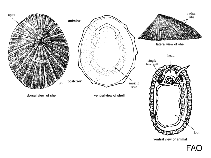Lottia digitalis (Rathke, 1833)
Ribbed limpet| Native range | All suitable habitat | Point map | Year 2050 |

|
| This map was computer-generated and has not yet been reviewed. |
| Lottia digitalis AquaMaps Data sources: GBIF OBIS |
Upload your photos
Google image | No image available for this species;
drawing shows typical species in Lottiidae.
Google image | No image available for this species;
drawing shows typical species in Lottiidae.
Classification / Names Common names | Synonyms | CoL | ITIS | WoRMS
Gastropoda | Not assigned | Lottiidae
Environment: milieu / climate zone / depth range / distribution range Ecologia
. Subtropical
Distribuzione Stati | Aree FAO | Ecosystems | Presenze | Introduzioni
Pacific Ocean: Alaska to Mexico. Climate: boreal to tropical.
Length at first maturity / Size / Peso / Age
Maturity: Lm ? range ? - ? cm Max length : 3.5 cm SHL maschio/sesso non determinato; (Ref. 312); common length : 3.0 cm SHL maschio/sesso non determinato; (Ref. 312)
Short description Morfologia
The peak near the front edge is far forward and may occasionally overhang the edge. The exterior varies in color but is usually brownish or olive green with a mix of large and fine dots. It is often pitted by a parasitic fungus and may have an eroded top (Ref. 312); Has a shell with an apex that is anterior. The anterior slope of the shell is concave and the posterior portion of the shell is convex. It has a strong ribbing on the posterior region. The shells are colored brownish green to greenish black and frequently appear eroded with white spots. The side of the foot is white (Ref. 310).
It has a shell length of 1.5 to 3.5 cm (Ref. 312).
Life cycle and mating behavior Maturità | Riproduzione | Deposizione | Uova | Fecundity | Larve
Reproduction: Spawning occurs in the winter, spring and summer. Has a short veliger stage. Typically the planktonic (veliger) larvae only remain in the water column for a few days to around a month. Recruitment of new individuals occurs typically from November to January. This short planktonic stage only allows for a limited dispersal of new individuals and recruitment is typically from the same or adjacent shore (Ref. 310).
Main reference
Bibliografia | Coordinatore | Collaboratori
Gallivan, G. and J. Danforth. 1999. (Ref. 312)
IUCN Red List Status (Ref. 130435: Version 2024-1)
CITES status (Ref. 108899)
Not Evaluated
CMS (Ref. 116361)
Not Evaluated
Threat to humans
Human uses
| FishSource |
Strumenti
Informazioni ulteriori
Trophic Ecology
Prede
Dieta
Consumo di cibo
Razione
Predatori
Dieta
Consumo di cibo
Razione
Predatori
Ecology
Population dynamics
Accrescimento
Age/Size
Length-weight
Length-length
Length-frequencies
Mass conversion
Reclutamento
Abbondanza
Age/Size
Length-weight
Length-length
Length-frequencies
Mass conversion
Reclutamento
Abbondanza
Life cycle
Distribution
Human Related
Profilo di acquacoltura
Stamps, Coins Misc.
Stamps, Coins Misc.
Outreach
References
Fonti Internet
BHL | BOLD Systems | CISTI | DiscoverLife | FAO(Publication : search) | Fishipedia | GenBank (genome, nucleotide) | GloBI | Gomexsi | Google Books | Google Scholar | Google | PubMed | Tree of Life | Wikipedia (Go, ricerca) | Zoological Record
Estimates based on models
Preferred temperature
(Ref. 115969): 6.4 - 14.2, mean 9.1 (based on 384 cells).
Price category
(Ref. 80766):
Unknown.



